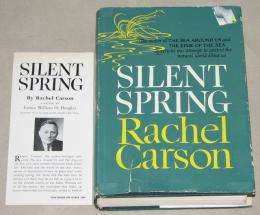September 28, 2012 report
Carson's Silent Spring turns 50

(Phys.org)—Silent Spring, by marine biologist Rachel Carson, was first published 50 years ago this month, and two Perspective articles in the Ecology section of the journal Science examine the legacy of this book, which inspired the environmental movement we have today.
In their article, "Life in a Contaminated World," Louis Guillette and Taisen Iguchi suggest the book dramatically changed the world's perception of the use of pesticides from being a benevolent aid to agriculture to being of serious concern to human health. They point out that the debate not only continues today, but has been widened to include all synthetic chemicals.
In a second Perspective article, "Insecticide Resistance After Silent Spring," David Heckel of the Max Planck Institute for Chemical Ecology in Jena, Germany, reminds us that Carson warned us that pesticides have other unforeseen effects, including killing off the predators that had previously kept pest insects in check, at the same time as many target species become resistant to the chemicals. Heckel reports that in the 50 years since Silent Spring's publication over 450 species of arthropods have become resistant to at least one pesticide and herbicide resistance has developed in a number of weed species.
Rachel Carson was born in 1907 in Pennsylvania and began writing early, publishing her first nature story when she was only 11. She later won a scholarship to study at Pennsylvania College for Women, and went on to John Hopkins University, where she gained a master's degree in zoology. She was unable to continue to a PhD because of financial difficulties. She became a marine biologist, spending much of her working life as a writer and editor for the US Fish and Wildlife Service. She lived a simple, quiet life and loved nothing better than to take long walks and observe nature.
The publication of Silent Spring, which took Carson four years to write, warned of a coming spring with no songbirds. Its publication led to a public awakening to the dangers of uncontrolled use of pesticides and other chemicals, and the activism that resulted led in turn to the establishment of organizations charged with protecting the environment, such as the Environmental Protection Agency (EPA) in the US.
Critics have always denied some of the warnings in her book. Soon after its publication representatives of pesticide manufacturers called her "hysterical" and themselves made the hysterical claim that she under sinister (ie. Soviet) influences, and her intention was to wipe out agriculture in the US. She was also under investigation by the FBI during the Hoover administration, but Kennedy later commissioned a review board that substantiated Carson's findings.
Some critics still use the three-pronged approach against Carson – Discredit the messenger, Deny the findings, and Delay action by calling for more research. Some are using the 50th anniversary of the book's publication to promote their own agenda, such as the libertarian think-tank, the Cato Institute, for example, which has published a book: Silent Spring at 50: The False Crises of Rachel Carson.
Rachel Carson wrote three other bestsellers: The Sea Around Us published in 1952, which was on the bestseller list for 86 weeks and earned her two honorary doctorates, The Edge of the Sea published in 1955, and the republished Under the Sea Wind first published in 1941. Even her critics admit she was an intelligent and gifted writer. She died of a heart attack in 1964 after being severely weakened by treatments for cancer.
Guillette and Iguchi suggest that study is still needed on the effects of synthetic chemicals and how they can, along with diet and stress, affect human genetics and create susceptibility to medical conditions and diseases.
Even though most of the chemicals Carson warned us about have now been banned, we are still awash with new chemicals - such as the BPA found in plastics (one study found 90% of Americans have BPA in their urine) and Monsanto's Roundup, which is used extensively - and the long-term effects of widespread exposure to them are still largely unknown.
Journal information: Science
© 2012 Phys.org














